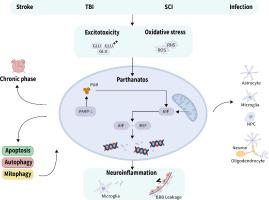当前位置:
X-MOL 学术
›
J. Adv. Res.
›
论文详情
Our official English website, www.x-mol.net, welcomes your feedback! (Note: you will need to create a separate account there.)
Exploring the role of parthanatos in CNS injury: Molecular insights and therapeutic approaches
Journal of Advanced Research ( IF 10.7 ) Pub Date : 2024-05-03 , DOI: 10.1016/j.jare.2024.04.031 Jiacheng Zhang , Xinli Hu , Yibo Geng , Linyi Xiang , Yuzhe Wu , Yao Li , Liangliang Yang , Kailiang Zhou
Journal of Advanced Research ( IF 10.7 ) Pub Date : 2024-05-03 , DOI: 10.1016/j.jare.2024.04.031 Jiacheng Zhang , Xinli Hu , Yibo Geng , Linyi Xiang , Yuzhe Wu , Yao Li , Liangliang Yang , Kailiang Zhou

|
Central nervous system (CNS) injury causes severe organ damage due to both damage resulting from the injury and subsequent cell death. However, there are currently no effective treatments for countering the irreversible loss of cell function. Parthanatos is a poly (ADP-ribose) polymerase 1 (PARP-1)-dependent form of programmed cell death that is partly responsible for neural cell death. Consequently, the mechanism by which parthanatos promotes CNS injury has attracted significant scientific interest. Our review aims to summarize the potential role of parthanatos in CNS injury and its molecular and pathophysiological mechanisms. Understanding the role of parthanatos and related molecules in CNS injury is crucial for developing effective treatment strategies and identifying important directions for future in-depth research. Parthanatos (from Thanatos, the personification of death according to Greek mythology) is a type of programmed cell death that is initiated by the overactivation of PARP-1. This process triggers a cascade of reactions, including the accumulation of poly(ADP-ribose) (PAR), the nuclear translocation of apoptosis-inducing factor (AIF) after its release from mitochondria, and subsequent massive DNA fragmentation caused by migration inhibitory factor (MIF) forming a complex with AIF. Secondary molecular mechanisms, such as excitotoxicity and oxidative stress-induced overactivation of PARP-1, significantly exacerbate neuronal damage following initial mechanical injury to the CNS. Furthermore, parthanatos is not only associated with neuronal damage but also interacts with various other types of cell death. This review focuses on the latest research concerning the parthanatos cell death pathway, particularly considering its regulatory mechanisms and functions in CNS damage. We highlight the associations between parthanatos and different cell types involved in CNS damage and discuss potential therapeutic agents targeting the parthanatos pathway.
中文翻译:

探索parthanatos在中枢神经系统损伤中的作用:分子见解和治疗方法
由于损伤造成的损伤和随后的细胞死亡,中枢神经系统 (CNS) 损伤会导致严重的器官损伤。然而,目前还没有有效的治疗方法来对抗细胞功能的不可逆转的丧失。 Parthanatos 是一种多聚(ADP-核糖)聚合酶 1 (PARP-1) 依赖性程序性细胞死亡形式,是神经细胞死亡的部分原因。因此,parthanatos 促进中枢神经系统损伤的机制引起了科学界的极大兴趣。我们的综述旨在总结parthanatos在中枢神经系统损伤中的潜在作用及其分子和病理生理机制。了解parthanatos及相关分子在中枢神经系统损伤中的作用对于制定有效的治疗策略和确定未来深入研究的重要方向至关重要。 Parthanatos(来自希腊神话中死亡的化身Thanatos)是一种程序性细胞死亡,由 PARP-1 过度激活引发。这一过程引发一系列反应,包括聚(ADP-核糖)(PAR)的积累、凋亡诱导因子(AIF)从线粒体释放后的核转位,以及随后由迁移抑制因子引起的大量DNA断裂。 MIF)与AIF形成复合物。次级分子机制,例如兴奋性毒性和氧化应激诱导的 PARP-1 过度激活,显着加剧中枢神经系统初始机械损伤后的神经元损伤。此外,parthanatos 不仅与神经元损伤有关,而且还与各种其他类型的细胞死亡相互作用。本文重点介绍有关parthanatos细胞死亡途径的最新研究,特别是考虑其在中枢神经系统损伤中的调节机制和功能。我们强调了parthanatos与参与中枢神经系统损伤的不同细胞类型之间的关联,并讨论了针对parthanatos途径的潜在治疗药物。
更新日期:2024-05-03
中文翻译:

探索parthanatos在中枢神经系统损伤中的作用:分子见解和治疗方法
由于损伤造成的损伤和随后的细胞死亡,中枢神经系统 (CNS) 损伤会导致严重的器官损伤。然而,目前还没有有效的治疗方法来对抗细胞功能的不可逆转的丧失。 Parthanatos 是一种多聚(ADP-核糖)聚合酶 1 (PARP-1) 依赖性程序性细胞死亡形式,是神经细胞死亡的部分原因。因此,parthanatos 促进中枢神经系统损伤的机制引起了科学界的极大兴趣。我们的综述旨在总结parthanatos在中枢神经系统损伤中的潜在作用及其分子和病理生理机制。了解parthanatos及相关分子在中枢神经系统损伤中的作用对于制定有效的治疗策略和确定未来深入研究的重要方向至关重要。 Parthanatos(来自希腊神话中死亡的化身Thanatos)是一种程序性细胞死亡,由 PARP-1 过度激活引发。这一过程引发一系列反应,包括聚(ADP-核糖)(PAR)的积累、凋亡诱导因子(AIF)从线粒体释放后的核转位,以及随后由迁移抑制因子引起的大量DNA断裂。 MIF)与AIF形成复合物。次级分子机制,例如兴奋性毒性和氧化应激诱导的 PARP-1 过度激活,显着加剧中枢神经系统初始机械损伤后的神经元损伤。此外,parthanatos 不仅与神经元损伤有关,而且还与各种其他类型的细胞死亡相互作用。本文重点介绍有关parthanatos细胞死亡途径的最新研究,特别是考虑其在中枢神经系统损伤中的调节机制和功能。我们强调了parthanatos与参与中枢神经系统损伤的不同细胞类型之间的关联,并讨论了针对parthanatos途径的潜在治疗药物。































 京公网安备 11010802027423号
京公网安备 11010802027423号